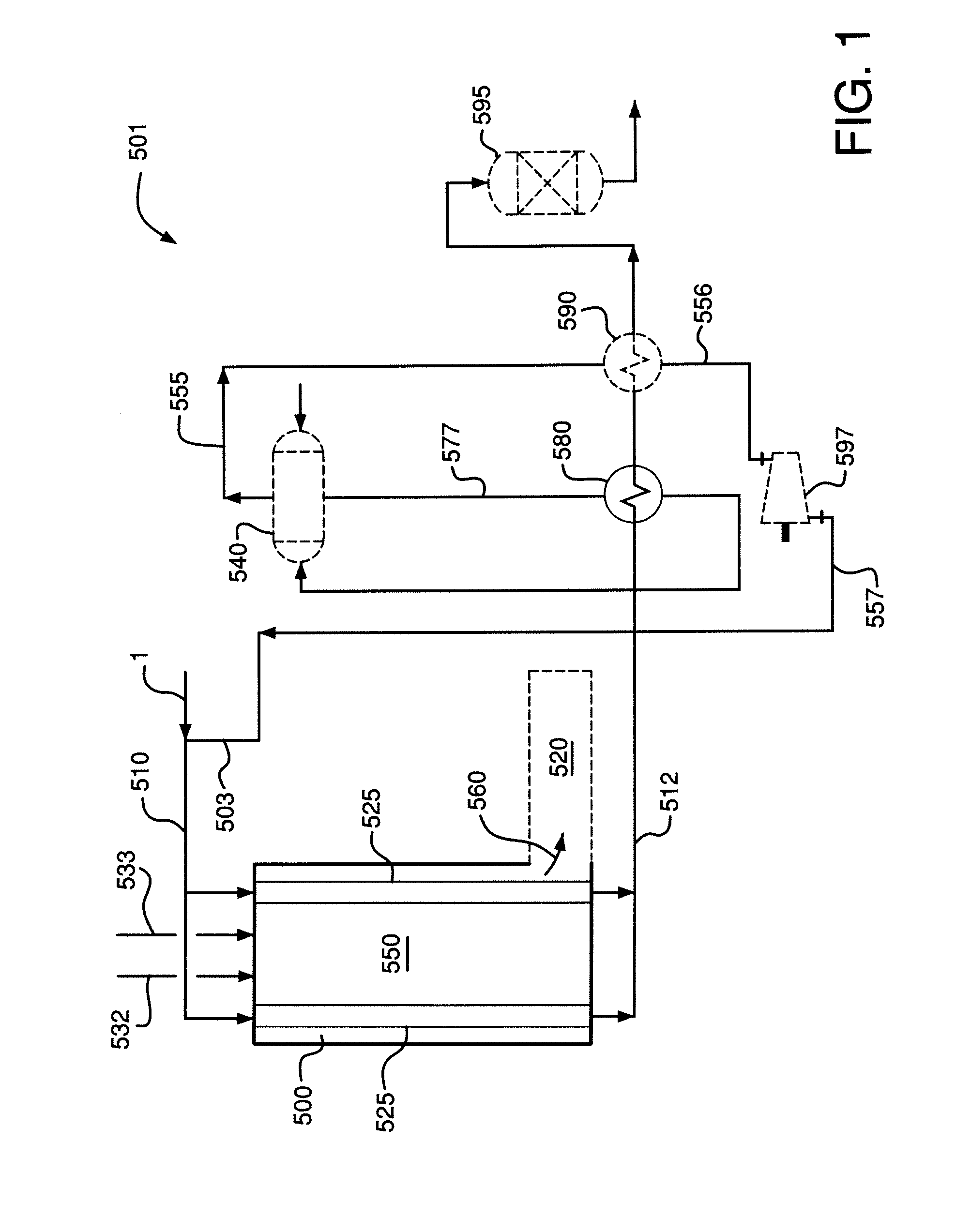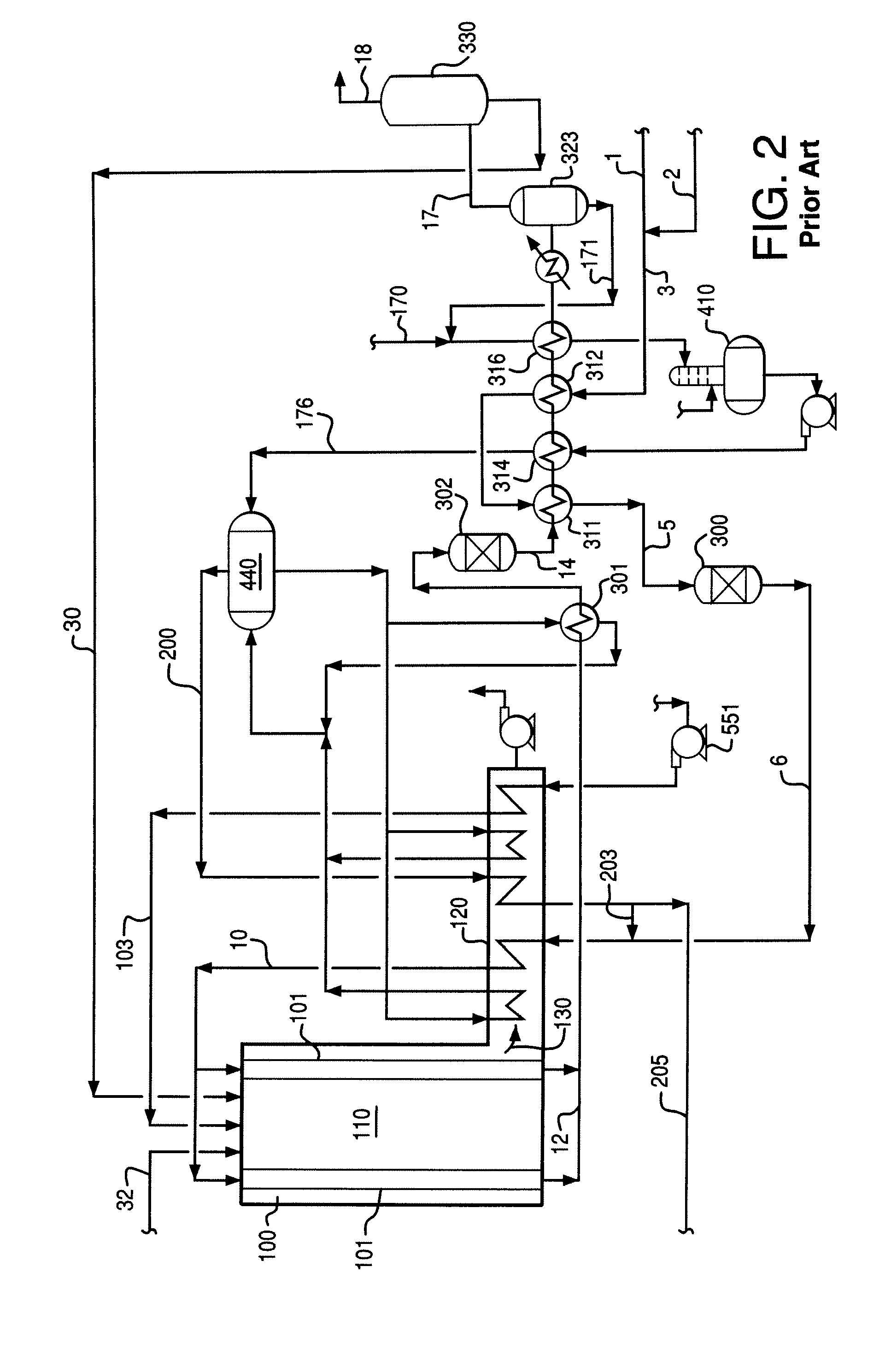Steam-Hydrocarbon Reforming Method with Limited Steam Export
a technology of steam hydrocarbon and export, which is applied in the direction of energy input, machines/engines, mechanical equipment, etc., can solve the problems of increased capital expenditure, increased cost, and inability to meet the needs of steam export, so as to maintain the overall plant efficiency and lessen the impact of plant efficiency
- Summary
- Abstract
- Description
- Claims
- Application Information
AI Technical Summary
Benefits of technology
Problems solved by technology
Method used
Image
Examples
example 1
[0095]The configuration according to Example 1 is shown in FIG. 2. FIG. 2 is a process flow diagram for a prior art-type hydrogen production facility. A reformer feedstock 1, in this example, natural gas is mixed with a hydrogen recycle stream 2 to form a hydrogen-containing feed stream 3. The hydrogen-containing feed stream 3 is heated via indirect heat exchange with a shift reactor effluent stream 14 from shift reactor 302 in heat exchangers 311 and 312. The shift reactor effluent stream 14 is formed from a reformed gas mixture 12 from the reformer 100 by reaction in shift reactor 302.
[0096]The heated hydrogen-containing feed stream 5 is introduced into hydrodesulphurization unit 300 to remove sulfur and form a sulfur-depleted reformer feedstock 6. Sulfur in the reformer feedstock is removed to prevent poisoning of reforming catalyst.
[0097]Reformer feed gas mixture stream 10 is formed from feed steam stream 203 and sulfur-depleted reformer feedstock 6 by mixing followed by indirec...
example 2
[0110]The configuration according to Example 2 is shown in FIG. 3. FIG. 3 is a process flow diagram for a prior art-type hydrogen production facility that includes a prereformer. With the exception of the adiabatic prereformer 105 and some heat exchangers, the configuration according to Example 2 is the same as the configuration according to Example 1 in FIG. 2. Where there are like elements in FIG. 2 and FIG. 3, like reference numbers are used.
[0111]A difference is that reformer feed gas mixture stream 10 is formed from feed steam stream 203 and sulfur-depleted reformer feedstock 6 by mixing followed by indirect heat exchange with combustion product gases in the convection section 120 of the reformer 100, prereforming in prereformer 105 and heating again in the convection section 120. Otherwise, the description of the configuration provided for Example 1 applies mutatis mutandis to the configuration of Example 2.
[0112]The process according to Example 2 was modeled using commercial ...
example 3
[0116]The configuration according to Example 3 is shown in FIG. 4. FIG. 4 is a process flow diagram for a prior art-type hydrogen production facility that includes a prereformer. In this configuration a medium temperature shift reactor 303 is used in place of a high temperature shift reactor. Some of the heat recovery has been modified accordingly. Otherwise, the configuration of Example 3 is very similar to the configuration of Example 2. Where there are like elements in FIGS. 2, 3 and 4, like reference numbers are used.
[0117]The description of the configuration provided for Examples 1 and 2 apply mutatis mutandis to the configuration of Example 3. Differences will be apparent to one skilled in the art based on the process flow diagram.
[0118]The process according to Example 3 was modeled using commercial process simulator software.
[0119]Input parameters and results for this configuration are summarized in Table 1.
[0120]As shown in Table 1, according to the simulation results, about...
PUM
| Property | Measurement | Unit |
|---|---|---|
| molar ratio | aaaaa | aaaaa |
| pressure | aaaaa | aaaaa |
| pressure | aaaaa | aaaaa |
Abstract
Description
Claims
Application Information
 Login to View More
Login to View More - R&D
- Intellectual Property
- Life Sciences
- Materials
- Tech Scout
- Unparalleled Data Quality
- Higher Quality Content
- 60% Fewer Hallucinations
Browse by: Latest US Patents, China's latest patents, Technical Efficacy Thesaurus, Application Domain, Technology Topic, Popular Technical Reports.
© 2025 PatSnap. All rights reserved.Legal|Privacy policy|Modern Slavery Act Transparency Statement|Sitemap|About US| Contact US: help@patsnap.com



